|
|
Review GSM/UMTS-smartphone Nokia N93
Nokia N93 live
photos>>>
Nokia N93 - 3.2
MP camera possibilities>>>
Standard kit:
- Nokia N93
- 128 MB miniSD-card
- Nokia Battery BP-6M
- Nokia Stereo Headset HS-23
- Nokia Travel Charger AC-4
- Nokia Charger Adapter CA-44
- Nokia Connectivity Cable CA-53
- Nokia Video Connectivity Cable CA-64U
- Protective Pouch CP-83
- Wrist Strap CP-84
- DVD-ROM with software - (Nokia PC Suite, Lifeblog, Adobe Photoshop
Album Starter Edition, Adobe Premiere Elements 2.0, Home Media
Server software)
On Nokia N90 release it was obvious that the company is intending
to apply the same design concept to several upcoming models. In
fact, its strength is ability to carry more sizable camera modules
without their functionality being cut, as when squeezing camera
into smaller casings. But for all that the device gets bigger: although
it incorporates mostly standard components like serial lenses and
hardware modules, its price falls down as compared to more portable
parts respectively. Basically the majority of manufacturers face
one and the same issue of costs, since the more compact a gadget
is, the more expensive it becomes. LG’s very own KG920 comes exactly
from that boat – its camera module takes up more than the half of
the device’s final price, while the prime cost of the KG920 is only
400 USD without regard for R&D cycle. That is how comes that
the manufacturer insists that a cell phone should be not only capable,
but popular as well. Thus sale rates may increase as the price comes
down, however it’s essential to keep profit rate at certain level.



In Nokia’s context this reasoning should be considered in light
of marketing policy of the manufacturer, implying that the company
tries out its all-new solutions with so called Techi audience (high-tech
gadgets lovers), and only the next generation delivers them to the
mass market. The enthusiasts don’t demand much of the novelties
when it comes to dimensions or weight. These consumers count on
extra functionality and innovative capabilities – for that they
will overlook every thing thaw would be unacceptable on the mass
market. To make it clear, bring up Nokia N90 in your memory, a Nokia’s
first handset to carry a 2 Mpix camera. After a while similar solutions,
yet without auto-focus and plastic lens have become widespread over
the Finnish manufacturer’s line-up. The inheritor of this product
line is Nokia N73, offering a 3.2 Mpix camera, compact casing in
candy-bar form-factor. The truth is, only these two are separated
only by three years, but look at the distinctions. If the former
handset was aimed at enthusiasts and could hardly meet the requirements
of mass market, the latter one covers almost the entire audience
and boasts of a portable shell.


Almost the same situation happens to Nokia N93 – the device won’t
fit the mass market, thus can’t be rated using this market’s criteria.
Will all parts on board (strap, memory card and stubs), the N93
weights 188 grams. Throwing aside all non vital accessories we will
get approximately 180 g. So this handset is obviously inferior to
mass products, which offer 100 grams of weight, while all up-to-date
smartphones are 130-140 g heavy. Due to bulky size of 118õ55.5õ28
mm it won’t slip in any pocket, especially in shirt’s one. Dimensions-wise
the phone is in a number of biggest devices on the market, and this
is it first major drawback.





Nokia N93 features two color schemes – silvery and black. According
to the surveys, bright gamma appeals more to women, while almost
all men choose black trim. Though I can’t imagine why women should
buy this phone, since its measurements will fit men audience more.
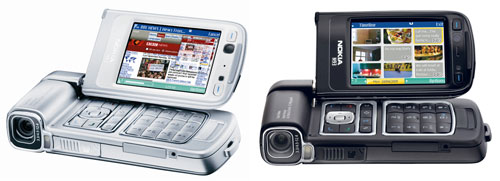
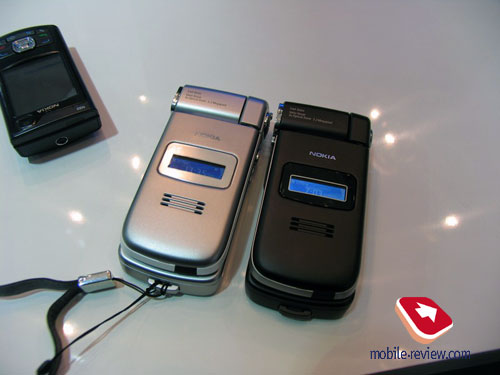
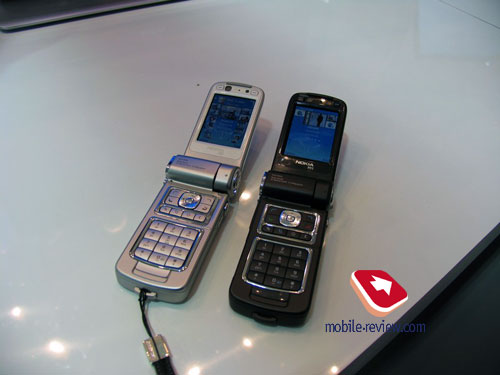
Unlike Nokia N90, where we saw twisting camera module, the N93
has it stationary, on top of that the design strongly associates
with that of Nokia N92. These two phone are very close size-wise
and powered by almost the same technical solutions. But if Nokia
N92 has more of a test model for operators providing mobile television
services and is available not in all retail stores, the N93 will
be sold world-over without limitations on local operators.
Video
handset’s outlook (wmv, 21.7 Mb)>>>
The top half of the folder may be twisted – the double joint is
located on the right part, to cut a long story short, you can open
the device like any other clamshell, or push the upper part sideways,
thus the screen will be horizontally-orientated in the first place.
The second degree of freedom allows twisting the main display towards
you once you have unfolded it – this reminds of the portable video
cameras, which use just the same mechanism. These actions actually
lead to different modes, automatically recognized by the system.
So when the screen is turned towards you and normal to the main
block, camera capabilities will be called up without your help.
Some devices by Voxtel, Samsung D550 and Samsung D300 operate exactly
in the same manner.




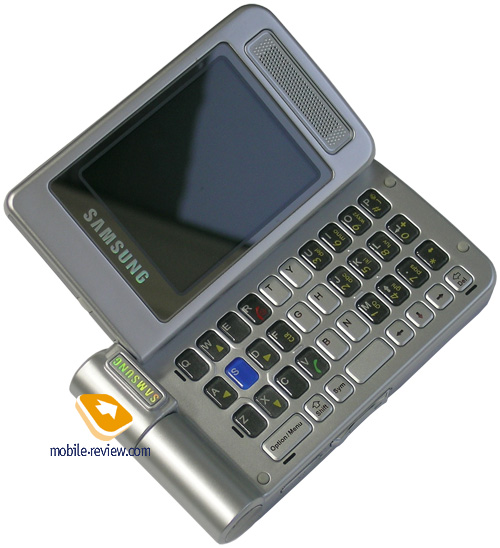

Building quality is fine – all details are well-adjusted and have
no gaps between each other. One could have expected the fastening
with a single joint to be unreliable, nevertheless it isn’t so.
Even if you shake the phone with all your strength, there is no
way the halves will move towards each other.





An external screen mounts the front panel and features a resolution
of 128õ36 pixels with 65 K colors (TFT). The display features not
only a standard bar with basic indicators, but also an extra text
one, which shows current time in standby mode. On incoming call
the number is shown that string, of course this display won’t offer
you the image of the caller. Turing the upper half so that the internal
screen will come on top is not possible – it’s a peculiarity of
similar designs. The display remains reading in sunlight, yet you
will have to find the right angle first. Presence of an external
screen is a major draw for this device, and the fact it is colored
only adds to the experience, though from my point of view it could
have been monochrome, since it features the very minimum of information.
The display may be customized with the help of additional wallpapers
set via the menu.



The speaker playing all the tunes finds its place under the screen
– even though it is loud enough, the one of the N91 still overcomes
it. The sides are the upper half are edged with a tiny line of bright
plastic, which make bulky size of the construction less evident.
The bottom rim houses Infrared port and strap slot, the latter detail
appears to be quite strange, since the N93 can be carried on your
hand, like any digital camera out there, yet handing it on your
neck may cause certain inconvenience.


Standard interface connector Pop-Port and slot for charger are
found on the left side play. The Pop-Port is covered with a plastic
stub, which is easily removed at any moment. miniSD expansion slot,
protected with a plastic stub fastened to the casing, is positioned
more towards the upper end. A miniSD card may be up to 2 Gb big;
even though the handset fully supports hot swap, I wouldn’t recommend
changing cards on the go for people, who store on them applications,
as well as various media files.


The power key mounts the top rim, the same button stands for switching
profiles while in standby mode.
The right rise features camera shortcut key. The trigger button,
marked with a red point, is originates from usual digital cameras,
as well as a ring rounding the key, which performs zooming. The
navigation key with OK button placed inside is located a bit lower
– it’s used for changing camera modes and browsing through the menus,
not in camera application. Frequently this very button allows managing
the handset single handedly; however the dimensions override this
handy possibility. Dedicated flash button becomes flashlight trigger
while in standby mode – to tell the truth this might be the only
application of the flash, as it doesn’t make much difference when
taking pictures, because it’s rather weak. The side “OK” button
locks and releases keypad lock, and once again, you can hardly make
use of it. The Shutter key turns the external display into monochrome
one, where you are shown current date and time.

The reason why the camera is integrated into the upper rim is not
its actual measurements, but rather presence of optical zoom. Size
of the matrix has remained pretty small and equals 4.5õ5.5 mm, therefore
images quality is not too far ahead of the competitors, however
implementation of glass lens and considerable focus length allow
acquiring good results. A small hood covering the lens which can
be fastened to the casing with a strap is also an appealing detail.
All in all, the manufacturer has succeeded in creating an illusion
of a tiny amateur camera.



Unfolding the device reveals the internal screen with a CIF-camera
located right above, which steps in when making video calls, yet
you are at liberty to take pictures with it as well, though there
is no practical use in it. A curios fact – this camera is armed
with a flash model, thus you can hold video calls even in darkness.

The area over the display contains two buttons, execution various
functions in some applications, however their primary predestination
becomes obvious when in camera mode, namely they call up advanced
options menus. The truth is, it is hard to operate these buttons
some times due to considerable weight of the handset, although when
holding the device sideways, they are more than just handy.
The internal display adopts the standard technology for its generation;
particularly this is QVGA resolution, 240x320 pixels. While the
N80 flaunts a diagonal of 2.2 inches, the N93 easily beats that
value with its 2.4 inches – the manufacturer has meaningly declined
the idea of embedding the N90 screen (352x416 pixels) in this unit,
as those displays are still pretty pricey. Obviously, the company
has held aside these cutting edge solutions for next generations
of Nseries devices; in fact we will have a chance to try that display
out with the N83 slider (the same one is found on Nokia N80). The
screen is capable of reflecting up to 262 K colors, what is quite
enough for any user. Similarly to all up-to-date TFT screen, this
display is equipped with a mirror layer, which prevents information
from fading in the sun. The same technology is applied on Nokia
N80, Sony Ericsson K790/K800. Thanks to this film, the viewing angle
achieved on this model is close to 160 degrees. Although this parameter
is not vital for mobile phones, unless you are going to watch video
with friends, yet the screen is still rather small for this entertainment.
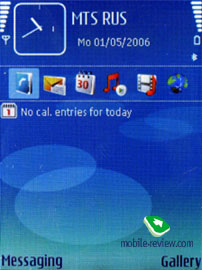

The color on screen seem to be bright and vivid, information is
easily readable, I’m not even talking about shots taken with the
built-in camera, which look really great and only stress display’s
excellent capacity. Not countingÅñëè Nokia N90, this model’s screen
claims leading positions in its class.
The keypad offers backlighting indicator, which may be switched
off if necessary. The keys themselves are pretty sizeable and soft;
basically the experience is great, though I can hardly imagine how
someone could expect something different in view of such big casing.
The soft keys are positioned in row right beneath the navigation
keys set – there is no joystick on this phone. The keypad’s surface
is lit in white, what makes it visible not in all environments,
yet don’t give much of a trouble.



Having removed the back panels, which, does not
have gap and hardly can obtain it in course of usage by the way,
you will discover SIM-card’s slot and also a battery. The phone
supports hot swap, yet it’s not recommended to switch cards while
the smartphone is on.

The handset makes use of a Li-Ion battery, namely the 1100 mAh
capable BP-6M. The manufacturer claims the life time of 240 hours
in stand-by mode and up to 5 hours of talk time (GSM-bands) or nearly
3 hours in UMTS-networks. Our unit lasted for about 1 day, yet over
that time we intensively used the camera and kept Bluetooth constantly
on. Therefore if you are not going to be heavy on such services,
you are more likely to squeeze about 2 days, just like on all up-to-date
Nokia’s smartphones, and I don’t think there will be significant
declinations from this value with this handset. Full recharging
takes a bit more than 2 hours.



Menu and other features
There’s no use in telling you about standard features of S60 3rd
edition over and over again, they were reviewed
in this article.
I highly recommend you reading that article, especially if you
are not familiar with OS and its realization of standard features,
meanwhile in this topic we shall speak about handset’s specialties,
how its ergonomics has changed. Photo part of N93 deserves separate
article, and it will be published shortly. Meanwhile now we shall
speak about main stuff.
Platform on which this model is based is different from latest
N-Series phones, including N91. Processor is operating at 314mhz,
this has been subjectively proven by tests, results were very high.
Amount of RAM is 32 megabytes, meanwhile 50mb are dedicated for
user’s needs. Amount of memory is not so big, especially if you
take high-res camera into consideration, so the first thing you
have to buy in case you are planning to take a lot of photos – is
s a 2gb memory card.
Video
sample, shows how menu can be operated in vertical mode (wmv, 3.1
Mb)>>>
Video
sample, shows how menu can be operated in horizontal mode (wmv,
10.1 Mb)>>>
Continuous evolution of interfaces lead to fact that nowadays Nokia
smartphones have audio and video ins, which makes it possible to
connect them to common household devices. Cable has standard “tulip”
connectors on one side, and Fast-Port connector on the other. Phone
supports following standards: PAL, NTSC. In settings menu you can
select display’s geometry – 16:9 or 4:3. This way signal will be
recognized instantly, and the picture will appear on both the handset
and the TV. And it’s not only viewing photos or video clips that
you can do, you can also play games, browse menu, do whatever you
like. But main reason for this cable is still viewing multimedia,
games do not look so good on TV, and menu is quite hard to browse
as well.
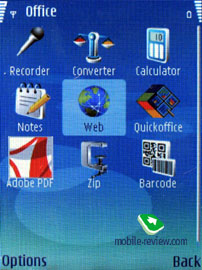
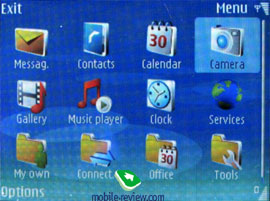
There were only few phones that had such capabilities of interaction
with household devices, most famous example is of course – Samsung
D600. Here you can also see presentations and office documents,
you just have to start required application.
Besides cable, there is another, more convenient way of displaying
multimedia content on screen of your TV or PC – it can be transferred
via WiFi. You must have required software on PC or a special multimedia
center that supports WiFi. Technically, working with such technologies
is no harder than sending file via Bluetooth. In future as conception
of “intelligent house” goes on expanding, more and more devices
that support connection with mobile phones, and interaction with
them will appear, and it’s not only about TVs, it’s much more than
that.

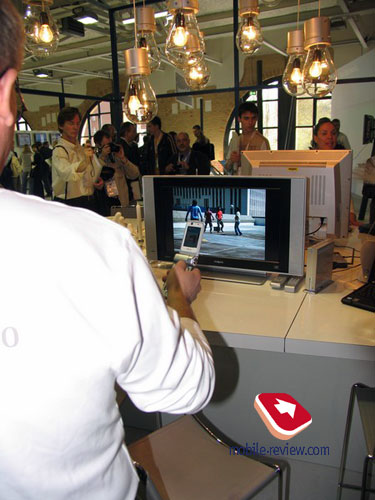
Handset supports Dual Transfer Mode (DTM), this allows transferring
voice and data in GSM/EDGE networks at same time, this is A class
device (multi slot class 11). A nice ability that makes this smartphone
closer to UMTS terminals that have this functionality by default,
without being one. One thing should be noted though, in case if
operator is not supporting DTM, there is no way you can use it.
At same time, there’s still EDGE B Class, multi slot class 32.
Handset can be connected to PC via USB. There are three modes,
you can select one of them as default, and it will be automatically
enabled when you connect your handset to pc:
- Mass storage – you connect your handset as storage device,
no drivers are required in this mode;
- PS Suite – standard mode;
- Picture Bridge – direct printer connection that supports this
standard.
Well, there’s almost no need in mentioning Bluetooth module’s presence,
it became sort of standard for smartphones. As for version, it’s
v1.2, and following profiles are supported: Basic Printing Profile,
Generic Access Profile, Serial Port Profile, Dial-up Networking
Profile, Headset Profile, Handsfree Profile, Generic Object Exchange
Profile, Object Push Profile, File Transfer Profile, Basic Imaging
Profile, SIM Access profile è Human Interface Device Profile. Several
connections can be made simultaneously. As for Bluetooth’s drawback:
there’s no A2DP profile support (stereo headset).
This handset has Wi-Fi (IEEE 802.11 g) support. All security standards
are supported: WEP , WPA , WPA 2, settings are maximally advanced,
although it’s hard to compare it with Zero Configuration in Windows
Mobile in terms of convenience of connecting. Device supports Universal
PnP standard (UPnP), which is successor of wired standard PnP. With
its help and usage of Wi-Fi you can send slides to TV, music to
stereo system, and photos to printer. At some point UPnP is similar
to upgrade over infrastructure (to Wi-Fi as example), especially
if you compare it to Bluetooth-like services, this looks like software
upgrade. So far support of this standard is interesting from theoretic
point of view, but it’s still something like tomorrow when we see
this standard being widely implemented, although the list of companies
that support this standard today is quite impressive. You can get
acquainted with documentation on UPnP here. A software named Home
Media Server is shipped on Software DVD, it allows connecting through
home Wi-Fi network to desktop PC.
Music player did not get any updates at a glance, but in fact this
handset now has full support of OMA DRM 2.0 and Janus DRM from Microsoft.
These technologies were supposed to be present in Nokia N91 at start,
but manufacturer was not able to do it in time, some other models
are missing it too. But by the time Nokia N93 will be released,
copyright protection will be fully ready.
Support of Janus DRM means full synchronization with Windows Media
Player 11, when connected via USB, handset will turn off network
block, and offers synchronization with this software. You can transfer
playlists, songs from PC to handset.
Music Library offers viewing all music files stored in phone’s
memory or memory card, they can also be sorted by genre, artist,
album or composer. Library can be updated automatically when you
add new music files. Unfortunate news for those who plan storing
large music collections – there is no search function at all. You
can only view songs manually via corresponding sections. On the
whole player is similar to different models produced by Nokia, except
for Nokia N91. As for sound quality, it’s ordinary, and is different
from Nokia N91.
Handset supports following music formats: eAAC+, AAC+, M4A, MPEG-4
ACC LC, LTP, MP3, AMR-NB, AMR-WB, 64 polyphonic MIDI, WMA. Most
interesting ones are: mp3 (all bit rates are supported, including
variable), AAC in all modes (for iTunes users), and actively promoted
WMA from Microsoft.
For any playlist you can enable shuffle, as well as repeat one
or all songs. There are several preinstalled equalizers, you can
adjust them manually. Well, it’s not like you will notice much difference
when switching between them, in order to actually do that, try setting
up last settings. Player can be minimized, in this mode you will
see song title and its playback time in stand by screen.
Built-in FM radio supports Visual Radio upgrade, when text and
image will be downloaded from radio’s site. This function looks
rather exotic, and it failed to get many followers. As for ordinary
radio, it supports not only 87.5 to 108mhz diapason, but also from
76 to 90 mhz.
Nokia Web Browser – standard browser, different
from those we’ve seen in previous models, similar to one in Nokia
N80. This is open-source development, which will be top-attention
spot in upcoming models.
One of browser’s possible disadvantages is its concept on the whole,
it displays pages the way they were designed, without any optimization
of content to fit device’s capabilities. Well, the picture will
get stretched to fit the screen, but still you have to scroll not
only vertically, but horizontally too. One of main concerns is that
browser downloads all what we can see on the page. We have made
a little test, by opening one and same pages with built-in browser
and Opera Mini. Opera’s software uses intermediate server for optimizing
content, scaling pictures. Difference was amazing in 3G network:
homepage of 220kb opened in built-in browser within 6 seconds, meanwhile
Opera Mini managed to do same operation within 3. Following research
showed up pretty much similar statistics. Meanwhile in EDGE/GPRS
networks it’s clear that Opera Mini is the leader, this solution
is also a must-have for those who prefer saving traffic.
Of course there are some consumers that demand content being displayed
“as is”, without any modifications. Built-in browser will be interesting
for them, but for most users this browser might become quite an
expensive toy in case if it’s used often, unless their operator
supports unlimited data transfer.
On the other hand, disadvantages that we mentioned above will go
away after 3-4 days since you’ve started working with that. First
of all, you come to realize that scrolling should not be done unless
the page has opened completely, otherwise you may end up with browser
crash. Browser also has mini-map technology, when you hold cursor
in any direction, you will see a small thumbnail of page and red
square which shows your current location. On the whole scrolling
page with help of mini map is convenient, although it’s not that
fast on big pages. Any page can be scaled from 50% to 125% (one
step – 25%). There can be up to 5 pages opened at once in separate
windows, in case they are “heavy”, you may run out of RAM, you will
be notified about that.
Another issue is history section of browser, in which you can see
thumbnails of pages you’ve visited. Though it becomes unclear why
pages load from start once you decide to visit them. Bookmarks are
common, they have auto-complete function for visited pages, so called
adaptive ones.
One of interesting parts of this browser is possibility to search
within one page, including local languages. In European versions
there will be all encoding s for Russian language, not only Unicode.
Browser operating speed is fine, there aren’t big problems with
this parameter, most importantly you should be aware of several
applications being active at same time. It seems we started with
a sad note, but let’s finish description of browser with something
more optimistic. At the moment this browser is very interesting,
and in case you take fact that it’s standard browser into consideration,
than it turns out not only interesting, but also nearly flawless.
You should spend couple of hours on learning how this thing works,
its peculiarities, get used to it. In case you are not aware of
pages being fully loaded, this solution will suit you for constant
usage.
Performance. Considering fact that this handset
is built on same hardware platform as Nokia N91, as well as some
other smartphones from Nokia, only changes that could have occurred
would be related to different display resolution. In 3D packet we
saw lower performance, meanwhile in Jbenchmark1, Jbenchmark2 we’ve
seen better results when compared to Nokia N91. Explanation is quite
simple – Java was optimized.
|
Nokia N91 |
Nokia N93 |
| JBenchmark 1 |
5483 |
6701 |
Details |
| Text |
1425 |
1842 |
| 2D Shapes |
1349 |
1660 |
| 3D Shapes |
745 |
783 |
| Fill Rate |
495 |
368 |
| Animation |
1469 |
2048 |
Screen Width
|
176 |
240 |
Screen Height
|
144 |
320 |
Color Screen
|
true |
true |
Number of Colors
|
16777216 |
16777216 |
Double Buffer
|
true |
true |
Total Memory
|
819200 |
819200 |
Free Memory
|
368252 |
349192 |
CLDC - 1.1.1 |
Microedition Profile MIDP-1.0
MIDP-2.0 |
Nokia N91-1/1.0606.009.05 |
|
Nokia N91 |
Nokia N93 |
| JBenchmark 2 |
485 |
638 |
Details |
| Image manipulation |
335 |
410 |
| Text |
710 |
897
|
| Sprites |
504 |
617
|
| 3d Transform |
789 |
1019
|
| User Interface |
281 |
457
|
Screen Width
|
176 |
240 |
Screen Height
|
144 |
320 |
Color Screen
|
true |
true |
Number of Colors
|
16777216 |
16777216 |
| JPEG Support |
true |
true |
| Transparency (Alpha Level) |
256 |
256 |
Total Memory
|
819200 |
819200 |
Free Memory
|
361860 |
297612
|
CLDC - 1.1 |
Microedition Profile MIDP-2.0 |
Microedition Platform: Nokia
N91-1/1.0606.009.05
|
Microedition Encoding: ISO-8859-1
|
|
Nokia N91 |
Nokia N93 |
| JBenchmark 3D HQ |
202 |
132
|
| JBenchmark 3D LQ |
333 |
132
|
| Triangles ps: |
51904 |
4450
|
| kTexes ps: |
2191 |
299
|
| Screen(canvas)width: |
176 |
240 |
| Screen(canvas)height: |
208 |
320 |
3D Subsystem |
| M3G Version: |
1 |
1 |
| Antialaising: |
false |
false |
| True color: |
false |
false |
| Dithering: |
false |
false |
| Mipmapping: |
true |
true |
| Perspective correction: |
true |
true |
| Local camera lighting: |
false |
false |
| Max lights: |
8 |
8 |
| Max Viewport dimensions: |
1024 |
1024 |
| Max Texture Dimensions: |
256 |
256 |
| Max Sprite Crop Dimensions: |
256 |
256 |
| Max Transforms Per Vertex: |
4 |
4 |
| Number of Texture Units: |
2 |
2 |
| Other properties: |
|
|
| Color Screen |
true |
true |
| Number of colors |
16777216 |
16777216 |
| Transparency (alpha level) |
256 |
256 |
| Double buffer |
true |
true |
| Total memory: |
1024 |
819200 |
| Free memory: |
1024 |
299304 |
MicroEdition Configuration
|
CLDC-1.1
|
CLDC-1.1
|
MicroEdition Profiles:
|
MIDP 2.0
|
MIDP 2.0
|
Microedition Platform:
|
Nokia N91-1/1.0606.009.05
|
Nokia N91-1/1.0606.009.05
|
Microedition Encoding:
|
ISO-8859-1
|
ISO-8859-1
|
Microedition Locale
|
en
|
en
|
Microedition Communication ports:
|
COM0, IR0, USB0, BT0-BT-63
|
COM0, IR0, USB0, BT0-BT-63
|
| Microedition Hostname: |
localhost
|
localhost
|
3.1.0 |
Conclusion
This handset has no problems with signal reception, voice of interlocutor
is clear, just like your own. Volume of 64-tone polyphonic ring
tone is average, but in case you choose mp3 file as ring tone, polyphony
does not matter that much. Vibrating alert is slightly lower than
average, sometimes you may miss a call due to that.
As for video recording, its resolution – this model is best on
the market once it will be released, same goes for photo quality,
but here difference in photos when compared to Sony Ericsson K790/K800
is insignificant. You will be able to find out more in our stand-alone
material, that will be dedicated to photo-part of Nokia N93.
One of unusual moments is presence of preinstalled software that
can work with office documents, including QuickOffice, this is one
of the best applications for Symbian. There’s also PDF-file reader.
All these applications are available for existing smartphones too,
you just have to pay for registration key.
The disappointing things are: limitation in Dictaphone – 1 minute,
it looks anachronistic today. Another disadvantage is size of the
device, it’s too big. But this is due to camera module, and other
parts of device too. For example, similar product Nokia N80 is smaller.
Manufacturer claims that this device supports full-screen video
playback in horizontal mode, but no matter how hard we tried, we
always had control icons and video was not stretching to full screen.
Except for these insignificant drawbacks, this device has no special
problems, platform on which everything is built is pretty well-spread
and reliable.
This device will go for sale in July, its price will be around
550-600 Euro, which is not that much considering the functionality.
It does not have direct competitors, this is another innovative
device for technological pioneers, including those who seek for
video recording in decent quality. This device will be in demand
for those who really need all those features. At same time there’s
Nokia N80 which is targeted at more common auditory, in future we
shall see Nokia N83, which is a hybrid of Nokia N91 and Nokia N80,
and it also has 5mpx camera. At same time Nokia N93 should be considered
as model on which company is trying out several new technologies.
This is common for manufacturers.
Comparing photos made with N93, Nokia N80 and Sony Ericsson K790
is the most interesting part, and you will be able to read about
it in next chapter, stay tuned!
Eldar Murtazin (eldar@mobile-review.com)
Translated by Alexandr "Lexx" Zavoloka
(alexander.zavoloka@mobile-review.com),
Oleg Kononosov (oleg.kononosov@mobile-review.com)
Published — 16 May 2006
Have something to add?! Write us... eldar@mobile-review.com
|
News:
[ 31-07 16:21 ]Sir Jony Ive: Apple Isn't In It For The Money
[ 31-07 13:34 ]Video: Nokia Designer Interviews
[ 31-07 13:10 ]RIM To Layoff 3,000 More Employees
[ 30-07 20:59 ]Video: iPhone 5 Housing Shown Off
[ 30-07 19:12 ]Android Fortunes Decline In U.S.
[ 25-07 16:18 ]Why Apple Is Suing Samsung?
[ 25-07 15:53 ]A Few Choice Quotes About Apple ... By Samsung
[ 23-07 20:25 ]Russian iOS Hacker Calls It A Day
[ 23-07 17:40 ]Video: It's Still Not Out, But Galaxy Note 10.1 Gets An Ad
[ 19-07 19:10 ]Another Loss For Nokia: $1 Billion Down In Q2
[ 19-07 17:22 ]British Judge Orders Apple To Run Ads Saying Samsung Did Not Copy Them
[ 19-07 16:57 ]iPhone 5 To Feature Nano-SIM Cards
[ 18-07 14:20 ]What The iPad Could Have Looked Like ...
[ 18-07 13:25 ]App Store Hack Is Still Going Strong Despite Apple's Best Efforts
[ 13-07 12:34 ]Infographic: The (Hypothetical) Sale Of RIM
[ 13-07 11:10 ]Video: iPhone Hacker Makes In-App Purchases Free
[ 12-07 19:50 ]iPhone 5 Images Leak Again
[ 12-07 17:51 ]Android Takes 50%+ Of U.S. And Europe
[ 11-07 16:02 ]Apple Involved In 60% Of Patent Suits
[ 11-07 13:14 ]Video: Kindle Fire Gets A Jelly Bean
Subscribe
|
















































